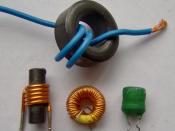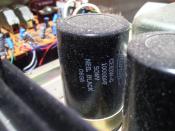Capacitor vs. Inductor
When most people think of an electronic device, they think that all it needs is a cord for it to work, but there is so much more through my eyes. Having over fifteen credits of electronics thus far, I learned to love it. I am currently in Elt 102, which deals with Ac circuits. One of the topics we spend most time with is inductors and capacitors. One may think that a capacitor and inductor are complete opposites, yet they have many strong similarities.
A capacitor is a passive electronic component that stores energy in the form of an electrostatic field. A capacitor opposes a change in voltage, which means that current leads voltage by ninety degrees. The unit of measure for a capacitor is a Farad or its symbol F. The main purpose for a capacitor is to store voltage. Once the circuit is turned, the capacitor will store up voltage to its capacity.
The larger the capacitor the more voltage it can store inside it. Usually the average size of a capacitor is not larger than a dime and is valued at a microfarad. The capacitor is a very simple device that has a positive lead and a negative lead coming out it. Inside the capacitor, the terminals connect to two metal plates separated by a dielectric. The dielectric can be made up of any material that does not conduct any voltage such as paper, plastic, and dry air. The capacitor will continue to give out voltage until it runs out or is grounded. While the capacitor deals with voltage, the inductor deals with current
In the other corner, sits the inductor and its simplest body. An inductor is a passive electronic component that stores energy in the form of a magnetic field. An inductor...


